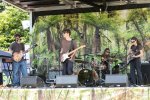Grant Haua - Album Review: Mana Blues
 If you’re not paying close attention, it would be easy to think Grant Haua has
a bout of the blues. His new 2023 album Mana Blues follows closely behind his 2022 release Ora Blues at the Chapel Vol. 1 and 2021’s album Awa Blues. Sadness indeed, but it’s not quite clear what’s the source of the melancholy.
Haua has quietly been accruing a quality career: he recorded four albums and toured for years as half of
Swamp Thing (with Michael Barker, who was also part of the classic line-up of the John Butler Trio), he’s been in the top 25 albums of the year
in Rolling Stone, played WOMAD and WOMADelaide, played the German music television show Rockpalast and occupied the number 1 spot on New Zealand albums sale charts. Why so sad?
If you’re not paying close attention, it would be easy to think Grant Haua has
a bout of the blues. His new 2023 album Mana Blues follows closely behind his 2022 release Ora Blues at the Chapel Vol. 1 and 2021’s album Awa Blues. Sadness indeed, but it’s not quite clear what’s the source of the melancholy.
Haua has quietly been accruing a quality career: he recorded four albums and toured for years as half of
Swamp Thing (with Michael Barker, who was also part of the classic line-up of the John Butler Trio), he’s been in the top 25 albums of the year
in Rolling Stone, played WOMAD and WOMADelaide, played the German music television show Rockpalast and occupied the number 1 spot on New Zealand albums sale charts. Why so sad?Mana Blues sees Haua trying to lift the blues away by swapping the acoustic guitars of his previous solo albums for electric guitars, on this 41-minute record – ostensibly of blues but, well, … not entirely. Mana Blues may not, in fact, be a purebred blues album at all but rather is something of a mixture of foot-tapping rootsy rock and roll, a bit of blues, some balladry and – just so it’s not all too agreeable – a couple of welcome history lessons too.
The album begins with the first of these, Pukehinahina, named after the 1864 Battle of Pukehinahina, when Maori were famously victorious over the British. Haua has whakapapa in the Bay of Plenty and has said he has been deeply moved by the “badassery” he discovered of his ancestors when researching that battle. Later in the album we hear Embers, a reflection on the tragedy of war and genocide in Europe during the last century, which also has moved him in ways previous research and songs have not. “The songs about war on this album are a departure from the norm as a writer for me. These are serious topics which I normally steer clear of, having not known the horror of it personally.” In Europe he “felt an incredible mix of sadness, loss, but also pride, awe and respect for men long in the ground,” – and here it’s inspired two of the strongest songs of the set.
The rest, he admits, is “standard fare.” It’s not so much blues as the reflections of, dare I say, perhaps a person who is feeling like they’re getting older. He can’t face going to work anymore (Blame It On A Monday), his woman’s making him jealous (Jealousy), he’s paying his dues (Aches), in fact almost every part of his body aches – ears, mind, nose, eyes, feet, toes, brain and bones – and he’s looking for a range of good stuff (Good Stuff). He has a momentary boost from remembering good times on Bad Mofo, as he remembers musical heroes of his past. But still here he settles for his own life of just having some rhythm and having some blues – which are “good enough for me.” It reminds me of one of Huey Lewis and the News’ biggest hits, Stuck With You – a reflection on whether settling for whatever it is you’ve got is going to be sufficient, with Lewis’ protagonist also conceding that he’s happy enough with that. For Haua, like it probably was for Lewis, I can’t help thinking this isn’t autobiographical at all, but rather just a pop song written for Generation X-ers to tap along to, sitting in their folding chairs with their sauvignon blanc in the sun.
These songs are indeed standard fare, though they are catchy, have cracking melodies and are well performed (Haua’s voice is great, and versatile, as is his guitar playing). The production, if anything, is too clean, as it doesn’t sound like a guitar band in your garage but rather one playing in a studio with a sound engineer making everything just-so. So, it’s foot-tapping stuff, light guitar rock and blues that will please many who are looking for a dose of something somewhat local, conventional, familiar and undemanding.
This is, except for the two war songs and – most notably – the only cover on the album, here called Time of Dying. This is a song with an interesting history. The original recording, made in 1927 by Blind Willie Johnson and called “Jesus Make Up My Dying Bed,” was itself a derivative of an earlier version. The earlier one was “Jesus goin’ a-make up my dyin’ bed,” which appeared in Robert Emmet Kennedy’s 1925 written account of Louisiana street musicians but was never even recorded until Johnson’s version. Josh White then recorded it as “Jesus Gonna Make Up My Dying Bed” in 1933, and then again in 1944 and 1946 as “In My Time of Dying.” And now you know the song I’m talking about …
It’s initial fame came though the recording made by Bob Dylan (“In My Time of Dyin’”) on his first album in 1962, where Dylan credited himself, of course, as the song writer. Later came the Led Zeppelin version “In my Time of Dying” on Physical Graffiti, where the credited songwriters were Bonham, Jones, Page and Plant.
That said, the versions are hardly similar in any respect except for the lyrics. Dylan’s version is not even three minutes long, whereas Led Zeppelin’s is over 11 minutes long. Haua cranks it out in just about 4 minutes, and it’s a blast. He ups the noise and the volume and breaks away from the middle of the track. In feel and energy, it has more of the immediacy and drive of much of Swamp Thing and, for me, along with the war songs here, was the standout material. Proper crunching blues guitar with deep bass and Hammond organ backing, it makes for a terrific song.
For many of us on a Sunday afternoon, with our glass of APA or sav in the sun next to a BBQ, the sound of Mana Blues through the open ranch sliders will hit the spot. But I suspect this may be an album with two kinds of fans – those who want more of the standard fare, and those who want more of Haua’s stuff from closer to the edge. Whatever, it seems Grant Haua is perhaps only half a step away from the Bad Mofos he reflects on here. Indeed, perhaps if he and the band played this material at that BBQ in our garden, he’d be just that – a Bad Mofo indeed – until the arrival of a noise control officer.
About Grant Haua

Foreword:
Grant is a “salt of the earth” kind of guy. When we put together a bio for him he said “Nah man. I am a just a guy with a guitar. You need to tell the story straight”. So who better than to tell his story than the man himself - the following is Grants bio, straight from the horse’s mouth. - DF Records
Visit the muzic.net.nz Profile for Grant Haua
Other Reviews By Michael Durand
 Craig Payne - Album Review: Born Again
Craig Payne - Album Review: Born Again
05 Jan 2025 // by Michael Durand
If you listen to the Blindboy Podcast or follow any other media by creative or neurodivergent people, you’ll know that most people hold back on creating anything because of their fear of failure, fear of judgement from others, or a fear of being defined by what they have produced rather than by who they are. (The first step is to simply get over ourselves and begin, knowing that we will certainly fail but that the only way to succeed is to start and stick with it.
Read More...
 Hoodaki - EP Review: Close Your Eyes It's Right In Front Of Your Ears
Hoodaki - EP Review: Close Your Eyes It's Right In Front Of Your Ears
18 Oct 2024 // by Michael Durand
There’s a post on Reddit called “A True Legend”: a clip of Fox 5 News reporter Ophelia Young interviewing a lottery player, with a live patch back to the studio. “Can I ask you, sir …” She approaches the man choosing his numbers.
Read More...
 Peace Love Perfection - Album Review: Nirvana Is Peace
Peace Love Perfection - Album Review: Nirvana Is Peace
29 Aug 2024 // by Michael Durand
Nirvana Is Peace the debut album from Wellington native and multi-instrumentalist Anthony Barnao’s project Peace Love Perfection – a 50 minute trip around psychedelia, EDM, jazz and mysticism. These are mostly instrumentals with low key dance grooves or classic jazz rhythms, Rhodes pianos, retro synths, funk bass lines walking across octaves, claves, shakers and central to the picture, Barnao’s inspired saxophone playing.
Read More...
 Toby Sussex - EP Review: Weather Dependent
Toby Sussex - EP Review: Weather Dependent
08 Jun 2024 // by Michael Durand
Toby Sussex’s debut EP Weather Dependent is a compact and ultimately satisfying set of singer-songwriter style reflections on life, death and relationships. It has catchy melodies and is well performed and produced, signalling at the outset that Sussex has what it takes to produce a full album in the singer songwriter genre.
Read More...
 Polite Company - Album Review: Please Go Wild
Polite Company - Album Review: Please Go Wild
24 May 2024 // by Michael Durand
I guess it’s not a surprise that after the Mutton Birds (Dominion Road, Anchor Me, etc.) all the members went on to further greatness: David Long to scoring movies and the Labcoats, Ross Burge to play drums for virtually all of New Zealand’s musical royalty, and Don McGlashen to solo notoriety.
Read More...
 The Feel Good Service - EP Review: DirtyFunknSoul
The Feel Good Service - EP Review: DirtyFunknSoul
24 Apr 2024 // by Michael Durand
Funk, soul and disco music seem to be so defined by their blueprints of the 1970's and 1980's that almost any serious modern attempt at them risks sounding nostalgic. As if these genres lived and died in history, and now we may only pay tribute to them – rather than contribute any further.
Read More...
 Repairs - Album Review: Disappointing Sequel
Repairs - Album Review: Disappointing Sequel
19 Apr 2024 // by Michael Durand
The following might be words that relate to the sound and feel of Disappointing Sequel, the second album from Repairs, out this week: tension, discordant contrarianism, tearing metal, nosebleeds, morse code, ensemble yelling, guitar feedback, aneurisms, anarchy machines, absolute defiance ….In case you didn’t know there’s a revolution coming and its being led out by Martin Phillips, James Milne and Nicola Edwards.
Read More...
 Seafog - Album Review: Slow Death
Seafog - Album Review: Slow Death
14 Apr 2024 // by Michael Durand
Port Chalmers four-piece Seafog have been with us for a few years now, pumping out some very well received doses of cross genre guitar type stuff — Raise Your Skinny Fist (2016), Dig It On Up (2017) and Animal Lovers (2019) — that each seemed to be spawned from a world none other than Port Chalmers itself. This week sees the release a further full album from the same place, Slow Death.
Read More...
Most Viewed Artists
Latest Galleries

Evan Rhys & the Stereo Streets @ Festival of Lights - Pukekura Park, New Plymouth - 18/01/2025
Midwave Breaks @ Festival of Lights - Pukekura Park, New Plymouth - 18/01/2025
Rumpus Machine @ Music in Parks, Aotea Square, Auckland - 18/01/2025
Fan Club @ Music in Parks, Aotea Square, Auckland - 18/01/2025
NZ Top 10 Singles
- APT.
ROSÉ And Bruno Mars - DIE WITH A SMILE
Lady Gaga And Bruno Mars - BIRDS OF A FEATHER
Billie Eilish - TASTE
Sabrina Carpenter - I LOVE YOU, I'M SORRY
Gracie Abrams - ESPRESSO
Sabrina Carpenter - SAILOR SONG
Gigi Perez - LOSE CONTROL
Teddy Swims - A BAR SONG (TIPSY)
Shaboozey - GOOD LUCK, BABE!
Chappell Roan






 Report A Problem
Report A Problem

